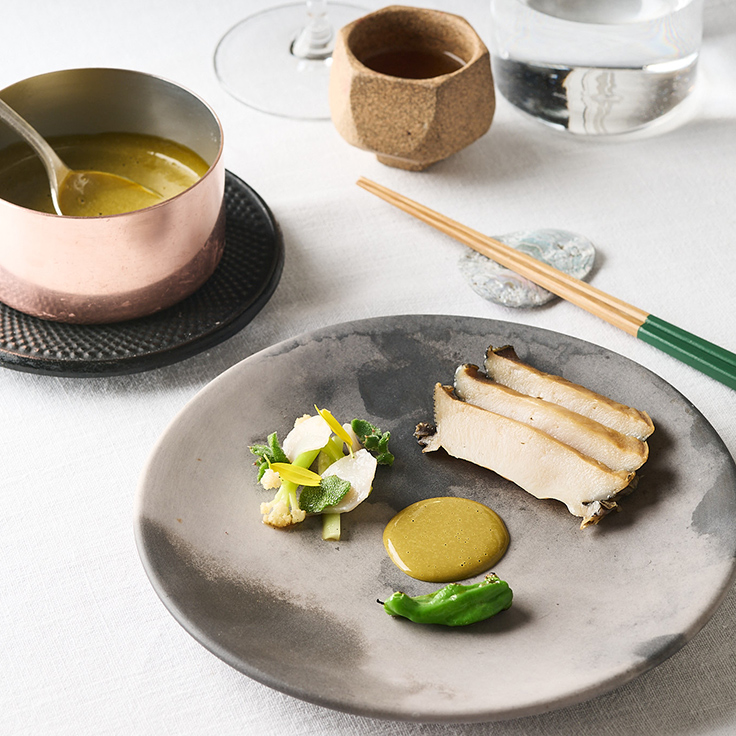Green gastronomy isn’t new, however, it’s fitting that the Sunshine State, that would be California, leads the way with 11 MICHELIN Green Star restaurants. From Elk (it’s near Sonoma) to Los Angeles, the Green Star restaurants champion sustainable practices while also acting as leaders in their profession continually innovating the dining experience from farm-to-table quite literally. With this in mind, we asked Chef Nancy Silverton of Chi Spacca, Chef Matthew Kammerer of Harbor House, and husband and wife duo Chef Kyle and Katina Connaughton of SingleThread on what can be implemented to shift the needle forward towards a more ecologically friendly dining experience and what sets each apart in the space.
Note: Interviews have been edited for clarity and length.
Chef Nancy Silverton, Chi Spacca:
Food waste is the bane of my existence! Give me a crystal ball and I won’t use it to get lottery numbers; I’ll use it to predict exactly how much food we will serve and you will eat. I’d rather be right about that than be rich. Sustainability is part and parcel with the food we make thanks to the decades-long relationships we’ve had with our purveyors who grow produce, raise and slaughter animals, with the same care we put into turning them into your dinner at Chi Spacca. We have some incredible meat dishes on the menu, but the food I want to eat every day is all over the Chi Spacca menu—seasonal salads layered with flavor and texture, vegetables simply seasoned and selected for their abundance and exuberant taste, and of course, the focaccia di recco. If we have a calling card, that’s it. The Recco tastes exactly like buttered matzoh. Restaurants are the final stop in that food system, and we chefs and restaurateurs have to always think about the processes and people that make it possible for us to put a dish down on your table.
Chef Matthew Kammerer, Harbor House:
For me, sustainability has always been in the background of my mind. As a cook working in two and three Star restaurants for the past ten years, what ends up on the plate involves so much waste. Not just in regards to food, but also the products, plastics, styrofoams, and how it got there. We cook for eighteen to 20 people a day so we start from scratch. If we have eighteen people coming in, we have eighteen portions. There is no waste, there is no prep to get ahead. Pretty early on, I let go of needing something. It’s always been, what do we have? We start with taste before flavor. Taste is the product before you’ve done anything to it. There’s truth in that. The menu is always up to the products we have and we cook off the cuff. Repetition is the thing I fear most: it’s always taste, taste, taste, taste, taste. We put so much effort into finding the products, that we don’t put them in the restaurant if we don’t believe in them. We grow a lot of our own food now so all we really have to do is not mess up the products. It’s à la minute cooking and we do everything at the last moment and try to preserve the integrity of the products. Being able to tell that story at the table, it’s not just about the industry, it’s about guests being like, “Oh I never thought about not getting what I wanted,” it’s inspiring for them as well and then we get to have the conversation where they start wondering where does my food come from.
Chef Kyle Connaughton and Head Farmer Katina Connaughton, SingleThread:
“[The dishes and menu are] wholly inspired by Katina’s farm. We’re having a conversation a whole year out for that season next year,” says Chef Kyle Connaughton of how he conceives of the menus at Three-Star Single Thread. "Everything we’re doing is driven by the farm [and] through the food, we’re telling the story. It’s a story that they’re participating in, rather than being in the audience and watching someone perform. You’re more actively participating and being present in that moment.” Wife and farmer Katina agrees, citing the couple’s time living and working in Japan as their guiding principles on hospitality and agriculture. “What I took away was their reverence for seasonality and for the entire life cycle of the natural world, finding the beauty from start to finish. Being able to connect with your food sources is ideal and necessary.” The farm is brought to life on the dishes created by Chef Kyle with purpose and thought. “It’s basically a giant puzzle,” says Chef Connaughton, adding, “you build your creativity around what showcases everything at the farm at that stage at that moment.” The balancing act of chef and farmer proves to be the pair’s winning hand rooted in mutual respect. “I cannot do what Kyle does. He’s a visionary. I saw it when I was 15 years old. He also leads his team and he himself holds so much respect for the farm and the farmers and creates his vision around what comes from the farm,” says Katina. “I can’t do what Katina does and I can’t do what I do without what she does. There’s this natural balance that occurs between the two of us. Together we’re creating the culture that is everything we do do for everyone. It’s my responsibility as a chef to showcase the hard work of the farmer and to tell her story and their story and have it really flow through us.”

Hero image: Harbor House chef Matthew Kammerer tidepooling along the Elk coast
© Matt Morris/Harbor House




















